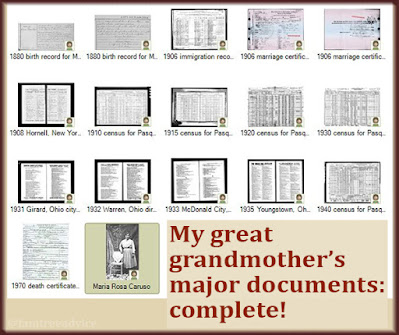Follow along as we figure out what's needed to "finish" documenting my grandmother's family.
 |
| It's time to work closer to home. Complete your closest families' documents. |
There's never going to be an end to the things you can learn about any given family in your family tree. But you can "close the book" on getting copies of their major documents.
You'll find this exercise more meaningful if you stick to your closest relatives. I'll choose my paternal grandmother Lucy, her brothers (Mike and Frank), and her parents (Pasquale and Maria Rosa).
The head of this family unit was my great grandfather Pasquale Iamarino. He was born in Italy, came to America in 1902, lived in New York and Ohio, and died in 1969.
I've had a lot of luck finding Pasquale's documents. (See "How to Use a Paper Trail to Recreate Your Ancestor's Life".) I have his:
- 1882 birth record from Italy and his baptismal record from the church
- 1902 ship manifest when he came to New York City
- 1905 New York State census
- 1906 marriage certificate with my great grandmother
- 1908 Hornell, NY, directory
- 1910 Federal census and 1915 New York State census
- 1918 World War I draft registration card
- 1920 and 1930 censuses when the family lived in Ohio
- 1931–1935 city directories from Ohio
- 1940 census
- 1942 World War II draft registration card
- 1969 death certificate from the state of Ohio
That's a pretty good haul! But there is a major piece of documentation I've never found for Pasquale. His naturalization papers.
The 1910 census calls him an Alien. The 1920 census says he had filed his naturalization papers. The 1930 census says he is a naturalized citizen. I can narrow it down further with his WWI draft registration card. In September 1918 he was a Declarant.
He began the citizenship process by September 1918, but did he file his papers in New York? He lived in Albany in June 1915, and he was an Alien on the 1915 state census. Or did he file his papers when he moved to Ohio?
I have a theory that Pasquale moved from New York to Ohio for a better opportunity with the railroad. Maybe the Erie Railroad preferred that he become a citizen.
It's a good bet that Pasquale filed his papers in the court nearest to Girard, Ohio, outside Youngstown.
 |
| My great grandfather's documents: so close to complete. |
That's one set of papers I need. What about the rest of this family of five?
For my great grandmother, Maria Rosa, I have her:
- 1880 birth record from Italy
- 1906 immigration record
- 1906 marriage certificate
- 1910–1940 censuses
- 1931–1935 city directories from Ohio
- 1970 death certificate
According to the 1940 census, she never became a citizen. I don't expect to find any other documents for her.
 |
| Since she doesn't seem to have become a citizen, my great grandmother's documents are complete. |
I'm missing my grandmother Lucy's birth and death records. Recently I solved the mystery of her missing birth record. I found her in a birth index with a misspelled last name and no first name. Now I have the document number and the wrong last name (Merino). I should be able to order that from New York, and I can order her death certificate from Ohio.
For my grandmother's brothers, my great uncle Mike and great uncle Frank, I have each census and lots of facts. As for their vital records, I have all the dates, but I don't have certificates of their births, marriages and deaths. I don't know about you, but I pay to get certificates only for my closest relatives. My dad loved these, guys, but I'm afraid I never met them.
So, the final tally of what I need before I can "close out" this family:
- Pasquale's naturalization papers, probably from Ohio
- Lucy's birth certificate from New York
- Lucy's death certificate from Ohio
I'm ashamed of myself for not having purchased my grandmother's 1954 death certificate. Somehow I overlooked it. And I'm even more ashamed that I never before figured out when my great grandfather became a citizen. (It still doesn't come up in a search.)
This is exactly why I'm encouraging us all to go back to basics. Look at the families closest to you—each of your grandparents' families for starters. Figure out what's missing:
- What can you find online?
- What will you have to send away for?
- What can you find on a genealogy road trip?
Take a day off from one of your distant-cousin-searches and come closer to home. Find the missing pieces for your closest relatives. Then share what you've learned with your family.








